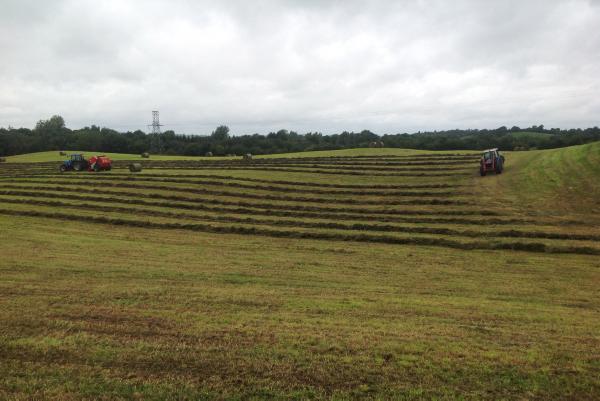Three dry days allowed our final winter feed requirements to be wrapped up. We have comfortably enough silage in store to see us through our relatively short winter.
It was cut down on Wednesday afternoon and raked up on Thursday evening and allowed to dry in the rows until Saturday morning when it was finally baled up. I was pleasantly surprised how dry it was and it should make excellent quality feed.
A lot will depend on the store price this autumn as to how much feed we will actually require. Every year is different, but because we feed silage only to our store bullocks over the winter, our demand per animal can be reasonably high.
Slatted shed
We are still in the middle of the final design for a slatted shed which we plan on building before the winter. It is dragging on longer then I would like, but with such a significant investment being made it pays to make the right decision.
We don’t have any existing slatted sheds on the farm so it is making the final decision harder as we have any “do’s or don’ts” from existing experiences. However, we have spoken to a number of people and are nearly there with regards a final idea.
I find with a lot of experience in farming, it pays to speak to other farmers to get their views and listen to all angles. But this build must tick a couple of boxes.
It has to be safe (agitation points on outside)
It must be clean and efficient (part time farming)It must be well ventilated to allow optimum performance (animal safety and comfort)Out-wintering
I have thought about the out-wintering option but decided against it. Ireland is unusual in that a very high percentage of animals are housed during the winter period in comparison to others countries and even our counterparts across the water. In most countries, it is common practice to feed animals over the winter on crops such as kale or fodder beet. I feel however this is only justified if a large land base is available or on large mixed farms which is common in the UK.
On the average sized family farm here, to devote enough area to feed the amount of livestock the farm carries over the winter, would reduce the total area for grazing efficiently over the summer substantial. So the benefit of cheaper wintering of cattle would be outweighed by the reduction in overall farm stocking rate.
Three dry days allowed our final winter feed requirements to be wrapped up. We have comfortably enough silage in store to see us through our relatively short winter.
It was cut down on Wednesday afternoon and raked up on Thursday evening and allowed to dry in the rows until Saturday morning when it was finally baled up. I was pleasantly surprised how dry it was and it should make excellent quality feed.
A lot will depend on the store price this autumn as to how much feed we will actually require. Every year is different, but because we feed silage only to our store bullocks over the winter, our demand per animal can be reasonably high.
Slatted shed
We are still in the middle of the final design for a slatted shed which we plan on building before the winter. It is dragging on longer then I would like, but with such a significant investment being made it pays to make the right decision.
We don’t have any existing slatted sheds on the farm so it is making the final decision harder as we have any “do’s or don’ts” from existing experiences. However, we have spoken to a number of people and are nearly there with regards a final idea.
I find with a lot of experience in farming, it pays to speak to other farmers to get their views and listen to all angles. But this build must tick a couple of boxes.
It has to be safe (agitation points on outside)It must be clean and efficient (part time farming)It must be well ventilated to allow optimum performance (animal safety and comfort)Out-wintering
I have thought about the out-wintering option but decided against it. Ireland is unusual in that a very high percentage of animals are housed during the winter period in comparison to others countries and even our counterparts across the water. In most countries, it is common practice to feed animals over the winter on crops such as kale or fodder beet. I feel however this is only justified if a large land base is available or on large mixed farms which is common in the UK.
On the average sized family farm here, to devote enough area to feed the amount of livestock the farm carries over the winter, would reduce the total area for grazing efficiently over the summer substantial. So the benefit of cheaper wintering of cattle would be outweighed by the reduction in overall farm stocking rate.






 This is a subscriber-only article
This is a subscriber-only article










SHARING OPTIONS: